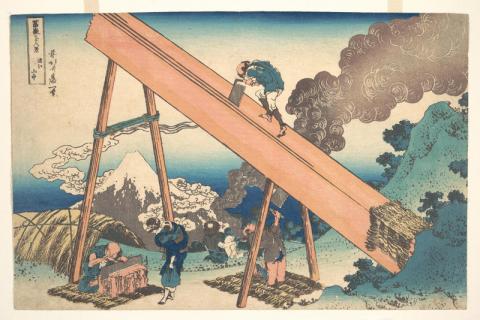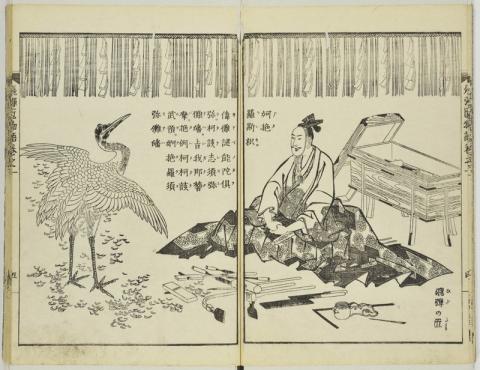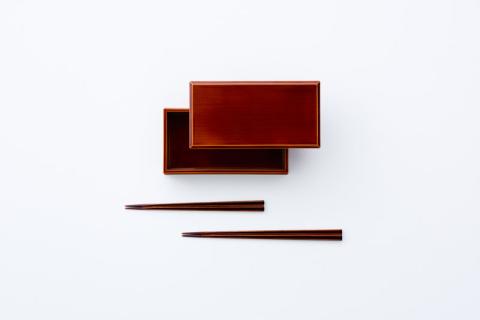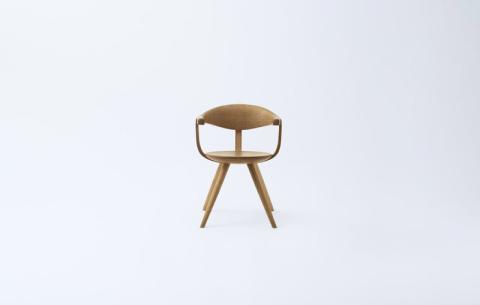Dates
01.16.2020 – 04.12.2020
Mon. - Sat.
10:00 AM – 8:00 PM
Sun.
10:00 AM – 7:00 PM
Location
JAPAN HOUSE Gallery, Level 2
Fee
Complimentary
The Hida region is one of the most recognized places in Japan for woodworking traditions. Located in the center of the country in Gifu Prefecture, its wood crafting history began 1,300 years ago. This exhibition aims to explore the heart of Japanese craftsmanship and aesthetic sensibility through the ever-present artistry represented in traditional Hida woodcraft techniques and products from its forests, from contemporary chair designs to fragrant aroma oils.
The exhibition is organized around four core principles as embodied in the work of Hida Sangyo Co., Ltd., one of the oldest furniture manufacturers in Japan, founded in 1920. The central ideas include coexistence with the forest (Forest), consideration of inherent human needs (Human), legacy cultivated through time (Time), and continuous refinement of craft (Craft). Together, they have contributed to the rich history of woodcraft in the Hida region.
In the beginning of the twentieth century, woodworking became the Hida region’s main commercial industry. This success has much to do with the innovations of Hida Sangyo, which continues to refine its manufacturing of bentwood furniture through the utilization of local forest resources.
The work of Hida Sangyo has become synonymous with the age-old skill and craftsmanship of the Hida region, and, yet, the company continuously seeks new methods of design and production. For example, collaborations with international designers enable Hida Sangyo to engage Western aesthetics with a Japanese style. The resulting pieces speak to a global audience and foster innovation while retaining the core principles of Japanese craftsmanship.
The company’s most recent innovations are in revolutionary wood-compression techniques with cedar, an incredibly sustainable domestic wood that is typically too soft and often not suitable for long-lasting furniture. In the Hida Sangyo factory, cedar is compressed and strengthened. This material transformation allows designers to create smooth and durable chairs, tables, and flooring imbued with cedar’s subtle scent. Hida Sangyo’s success has influenced a community of other manufacturers to flourish in the Hida area, incorporating the time-honored mastery of the region’s woodcraft.
The exhibition highlights the Hida region’s enduring craft connections to wood and the forest. The featured objects and processes engage the five senses and touch upon all aspects of contemporary lifestyle. From the raw materials of the forest, the origins of Hida’s craft traditions, to the furniture designs developed by Hida Sangyo in collaboration with some of the world’s top contemporary designers, such as Enzo Mari and Sori Yanagi, the exhibition spans the evolution of Hida’s relationships with the Forest, Human needs, Time, and Craft.
Forests are the genesis of the Hida region’s creativity. The techniques of Hida’s craftsmen have been honed by the area’s deep forests. The diverse tree species and high-quality timber have nurtured a woodworking culture for 1,300 years. For the people of Hida, coexisting with the forest is a partnership. Gratitude and care are offered to the life-giving forests as they are bequeathed to future generations. Both co-existence and co-prosperity are at the heart of Hida craftsmanship.
Beyond innovative technology, the Hida craftsmen have endeavored to fulfill intrinsic sensory needs that instill human satisfaction, such as comfort, ease of use, and a sense of familiarity. Dedicated to the five senses, Hida craftsmanship, at its core, has not changed throughout its 1,300-year history. Today’s craftsmen continue to anticipate, and give great attention to, the feelings of the end user.
It is not possible to speak of HIDA without mentioning the renowned and pioneering Hida no takumi, or craftsmen of Hida. These master craftsmen possess preeminent woodworking techniques enriched through time, and have contributed to the construction of shrines, temples, and even imperial capitals for 1,300 years. The history of Hida exists as a continuum, proudly maintaining the techniques, shapes, and ideas produced and nurtured by these pioneers for successive generations.
The Hida area has produced highly refined techniques that are respected worldwide, including Hida-shunkei lacquerware, Ichii wood carving (Ichii itto bori—Japanese yew carving), and mageki (wood bending). The history of Hida is also a history of continuous innovation and of sharing the appeal and potential of wood with the outside world. The refinement of skill is a fundamental characteristic of Hida craft that remains unchanged, while the study and evolution of technique is an unceasing journey.
This exhibition provides an opportunity to experience the current progress of this journey through contemporary furniture and lifestyle goods made by Hida craftsmen, while enjoying the charm and soulfulness of wood and the ever-evolving aesthetic of Japanese craft.
HIDA Exhibition Brochure
The PDF version is available. Download the exhibition brochure.
Exhibition Highlights

1. Katsushika Hokusai (1760–1849), Japan
In the Mountains of Tōtomi Province (Tōtomi sanchū), from the series Thirty-six Views of Mount Fuji (Fugaku sanjūrokkei), Edo period, c. 1830–32, Japan, Polychrome woodblock print; ink and color on paper (Digital Reproduction).
Read more.
This is an illustration by Katsushika Hokusai (1760-1849), a Japanese artist best known as a woodblock printmaker during the Edo period (1615–1868). Born to an artisan family in present-day Tokyo, he began painting at a young age and became an apprentice to a wood-carver as a teenager. This series of woodblock prints, in which Hokusai captured perspectives of Mt. Fuji from various vantage points, was produced just as domestic travel was becoming popular in Japan. As in this work, his prints often captured glimpses of everyday life in the Edo period Japan. His most famous work is “The Great Wave off Kanagawa.”

2. Hida at a Glance
Hida is located in the center of the main island (Honshu) in Japan. Hida Takayama has 93% forest coverage, the highest proportion in Japan, and is considered an outstanding “forest town.” Hida experiences significant temperature variation over the course of the year, ranging from 5°F (-15°C) to 86°F (30°C), as well as heavy snows. These conditions elicit slower tree growth, leading to tighter growth rings and resulting in delicate yet sturdy, high-quality timber.
Read more.
The diverse tree species and high-quality timber have nurtured a woodworking culture for 1,300 years in the Hida region.
During the Nara Period (AD 710–784), 1300 years ago, government officials recognized the exceptional skill of the wood craftsmen in the Hida region. The region was offered a unique opportunity to provide 100 craftsmen each year, in place of taxation to create shrines, temples, and contribute work to the royal palace and other buildings related to government.
This relationship became known as the “Hida no takumi” system. In general, it was the second, or third, son from a woodworking family that was chosen to go to the capital at Nara to build temples and shrines for a year. As their reputation grew, the craftsmen from Hida were placed in supervisory roles at many construction sites. The Hida no takumi system came to an end during the Heian period (AD 794-1185) when the capital moved to Kyoto.
Over the 500 years the system was in place, 40,000 workers were sent to the capital from the Hida region.

3. The Story of the Craftsman of Hida (Hida no takumi monogatari), c.1809
Written by Masamochi Ishikawa (1753―1830) Pictures by Katsushika Hokusai (1760–1849)
The book contains several tales that are based on the exploits of the craftsmen from Hida.
Featured Story: Takumi no udekurabe (A challenge match between the master craftsman of Hida, Takumi and master painter Kawanari Kudanari)
Read more.
Once upon a time, there were two incomparable master craftsmen who were well-known for their competition: Kawanari, a master painter, and Takumi, a master carpenter.One day, Takumi built a four-sided temple and invited Kawanari to his house to see him and paint on his walls. When Kawanari went to the house, he encountered a very interesting small hall, in which all four doors – one each to the north, south, east and west – were open. Invited by the master carpenter to look inside, Kawanari went up to the porch and tried to enter. However, each time he approached a door, it would close quickly, only to re-open as he arrived at the next door just as it closed. After going around and around and trying to enter many times, Kawanari finally gave up. Seeing this, Takumi laughed terribly, and Kawanari went home frustrated.
A few days later, it was master painter Kawanari’s turn to invite the master carpenter to his house. Takumi knew this was to be revenge for the previous day’s experience but was so persistently and politely summoned that he finally decided to go.
Arriving at the master painter Kawanari’s house, Takumi opened the door from the corridor to find a large, blackened corpse lying in the room and the odor of decay filling his nostrils. Takumi screamed and jumped out of the room where Kawanari remained, laughing terribly at Takumi’s shrill escape. Takumi was terrified and stood in the garden, where Kawanari came out to find him and explain that what he saw was actually only a picture of a dead man drawn on the screen.

4. Hida Shunkei Lacquerware
Hida has an enduring lacquerware culture, featuring products crafted by a repeated layering of natural lacquer (urushi) on wood or paper. Takayama City’s Hida-shunkei lacquerware emerged from spiritual respect for the long-standing woodcraft creations of Hida’s master craftsmen.
Read more.
A key characteristic is the harmony between the unique clear lacquer and the beauty of the natural wood grain. Initially, the technique was used in refined trays, containers, and tools such as those used for tea ceremonies, but gradually its application expanded to everyday items such as chopsticks and bowls.
Hida Shunkei Lacquerware is recognized as one of Japan’s nationally certified traditional handcrafts.

5. Sori Yanagi, Product Designer (1915-2011)
Sori Yanagi played an essential role in leading modern Japanese design after World War II into the Japanese economy's high-growth period from the mid-1950s to the early 1970s.
He was born in 1915 in Tokyo, Japan, as the son of Muneyoshi Yanagi, who founded the mingei movement, which celebrated Japanese folk crafts and the beauty of everyday objects. Muneyoshi established the Nihon Mingeikan, the Folk Crafts Museum of Japan. Sori entered Tokyo Art School in 1934, where he studied both art and architecture.
Read more.
After World War II, Sori designed a wide range of products: furniture, three-wheeled vehicles, Olympic cauldrons, pedestrian overpasses, and more. One of his most famous pieces of furniture is the Butterfly Stool, which won gold prizes at the Milan Triennial XI, in 1957. His works are included in the collections of MOMA, New York, the Rubell Museum, Miami, and others. Most of Sori's designs are elegantly simple. Sori Yanagi passed away in 2011 at the age of 96.
About the Sori Yanagi armchair featured in the HIDA exhibition:
Sori designed this chair and began initial production with several companies in 1978. However, the extended arms which connect, becoming the chair back, were complicated to create from a single piece of wood. Early fabricators attempted to realize this one piece by combining three pieces of wood. This process proved uneconomical for mass production, and the design was shelved.
In 1990, Sori made another attempt to create this chair, this time with a bentwood furniture company. However, again it involved too much time and hand-labor to realize a marketable final product, and they moved away from the design.
In 2005, while Hida Sangyo was exhibiting Italian Designer, Enzo Mari in Tokyo, Mari brought Sori Yanagi and Hida Sangyo Co., Ltd. together. After this meeting, Sori decided to make one last attempt to create his chair with Hida Sangyo Co., Ltd. Design work started Feb of 2006. The chair and fabrication process were ultimately finalized in 2010 using the company’s proprietary wood bending and compression technology. Sori eventually designed a table to go with the chair. Both the chair and table continue to be high demand products for Hida Sangyo Co Ltd.
Gallery Photos
*To view the flipbook in full screen, please click on the "Fullscreen" icon on the lower right-hand corner from the window above.
Related Programs
Exhibition-related programs and workshops which complement HIDA | A Woodwork Tradition in the Making will be introduced on the Events page.
Exhibition Credits
Presented by JAPAN HOUSE Los Angeles
Exhibition contents provided by Hida Sangyo Co., Ltd.
Exhibition and Graphic Design | Daigo Daikoku
Planning and Production Assistance | Intertrend Communications, Inc.
Content Contribution | City of Takayama Historical Archive Department
Planning Support – City of Takayama

